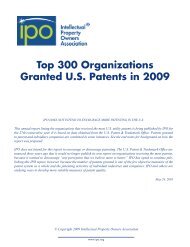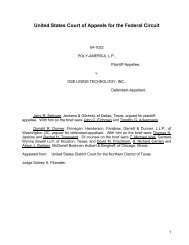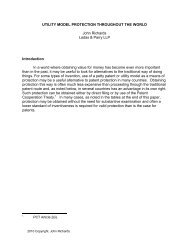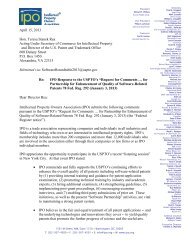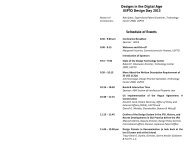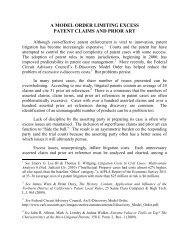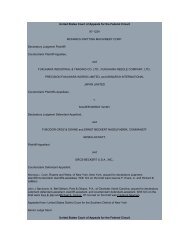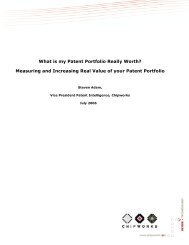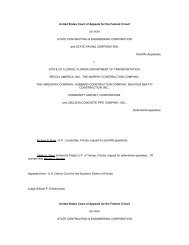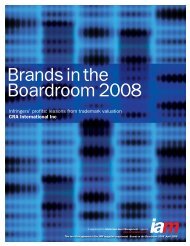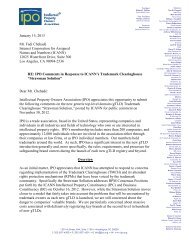Ruiz v. A.B. Chance Co.
Ruiz v. A.B. Chance Co.
Ruiz v. A.B. Chance Co.
Create successful ePaper yourself
Turn your PDF publications into a flip-book with our unique Google optimized e-Paper software.
Fasteel had offered clear and convincing evidence that claim 6 of the ’368 and ’107 patents was also invalid<br />
for obviousness.<br />
I. Obviousness under 35 U.S.C. § 103<br />
Opinion<br />
A claimed invention is unpatentable due to obviousness if the differences between it and the prior art "are<br />
such that the subject matter as a whole would have been obvious at the time the invention was made to a<br />
person having ordinary skill in the art." 35 U.S.C. § 103(a). A patent is presumed valid, and the burden of<br />
establishing invalidity as to any claim of a patent rests upon the party asserting such invalidity. 35 U.S.C. §<br />
282 (1994). In order to determine obviousness as a legal matter, four factual inquiries must be made<br />
concerning: 1) the scope and content of the prior art; 2) the level of ordinary skill in the art; 3) the differences<br />
between the claimed invention and the prior art; and 4) secondary considerations of nonobviousness, which<br />
in case law is often said to include commercial success, long-felt but unresolved need, failure of others,<br />
copying, and unexpected results. Graham v. John Deere <strong>Co</strong>., 383 U.S. 1, 17-18, 148 USPQ 459, 467<br />
(1966); Miles Labs., Inc. v. Shandon, Inc., 997 F.2d 870, 877, 27 USPQ2d 1123, 1128 (Fed. Cir. 1993). We<br />
review the ultimate determination of obviousness de novo, while the underlying factual inquiries are<br />
reviewed for clear error. See Weatherchem <strong>Co</strong>rp. v. J.L. Clark, Inc., 163 F.3d 1326, 1331, 49 USPQ2d 1001,<br />
1006 (Fed. Cir. 1998). "‘A finding is clearly erroneous when, although there is evidence to support it, the<br />
reviewing court on the entire evidence is left with the definite and firm conviction that a mistake has been<br />
committed.’" In re Graves, 69 F.3d 1147, 1151, 36 USPQ2d 1697, 1700 (Fed. Cir. 1995) (quoting United<br />
States v. United States Gypsum <strong>Co</strong>., 333 U.S. 364, 395 (1948)). Fed. R. Civ. P. 52(c) is applicable to all<br />
findings of the four inquiries in Graham. Rule 52(c) says that judgments must be "supported by findings of<br />
fact and conclusions of law."<br />
In determining obviousness under section 103, the district court said that the issue "is whether a<br />
combination of the teachings of the prior art would have suggested what the patent does." The district court<br />
added that "if the prior art implicitly suggests combining the teachings of the prior art, and the claimed<br />
invention doesn’t do any more than combine them, then it is invalid." Applying those standards, the district<br />
court concluded that the ’368 and ’107 patents "would have been obvious to that hypothetical ordinary<br />
person skilled in the art of foundation underpinning based on the teachings of the Gregory ’580 and ’777<br />
patents, combined with what Fuller and Rupiper were doing with helicals [screw anchors] and concrete<br />
haunches." The district court noted that "[o]nce the idea emerged to use helicals [screw anchors] for<br />
remedial foundation work, the need for a bracket was apparent." This conclusion of what the court called a<br />
"text book case of obviousness" was based on "[the judge’s] study about what was disclosed, the prior art,<br />
the undisputed testimony in this case, and those parts of the testimony of the witnesses that [the judge]<br />
believe[d]." The district court found that all relevant prior art was disclosed to the patent examiner. The<br />
district court’s opinion did not mention Graham, nor did it provide an analysis of what was disclosed, the prior<br />
art, or the testimony presented by the parties. <strong>Chance</strong> appeals the district court’s finding of invalidity,<br />
arguing that the district court erred in failing to conduct a Graham analysis.<br />
A. Application of the Graham Factors<br />
Our precedent clearly establishes that the district court must make Graham findings before invalidating a<br />
patent for obviousness. See Jones v. Hardy, 727 F.2d 1524, 1529, 220 USPQ 1021, 1025 (Fed. Cir. 1984)<br />
("Graham was cited but its guidance was not applied, resulting in the application of hindsight and<br />
speculation."); Custom Accessories, Inc. v. Jeffrey-Allan Indus., Inc., 807 F.2d 955, 961, 1 USPQ2d 1196, 1200<br />
(Fed. Cir. 1986) ("[W]hen significant legal errors are reflected in the opinion, . . . which themselves shed<br />
doubt of the district court’s use of Graham, the need for findings becomes greater and their absence rises to<br />
the level of error."). In Loctite <strong>Co</strong>rp. v. Ultraseal Ltd., 781 F.2d 861, 228 USPQ 90 (Fed. Cir. 1985),overruled<br />
on other grounds by Nobelpharma AB v. Implant Innovations, Inc., 141 F.3d 1059, 46 USPQ2d 1097 (Fed. Cir.<br />
1998), we said:<br />
In patent cases, the need for express Graham findings takes on an especially significant role because of an<br />
occasional tendency of district courts to depart from the Graham test, and from the statutory standard of<br />
unobviousness that it helps determine, to the tempting but forbidden zone of hindsight. Thus, we must be<br />
convinced from the opinion that the district court actually applied Graham and must be presented with



